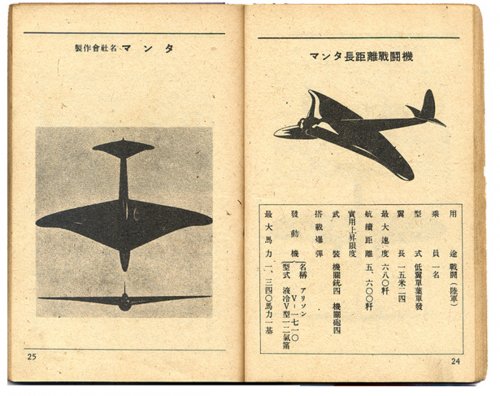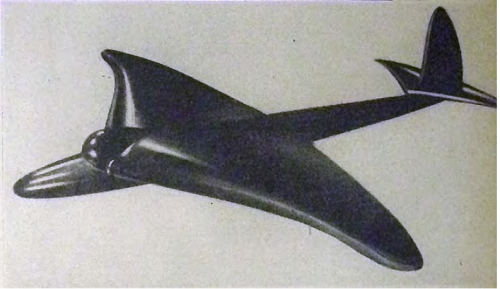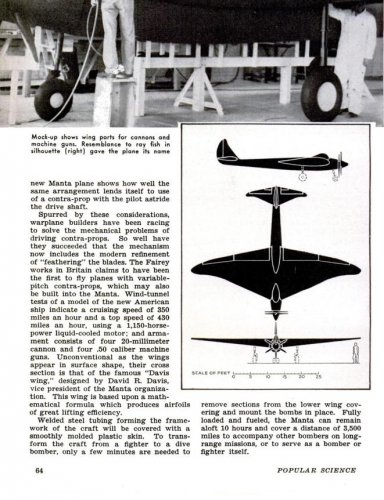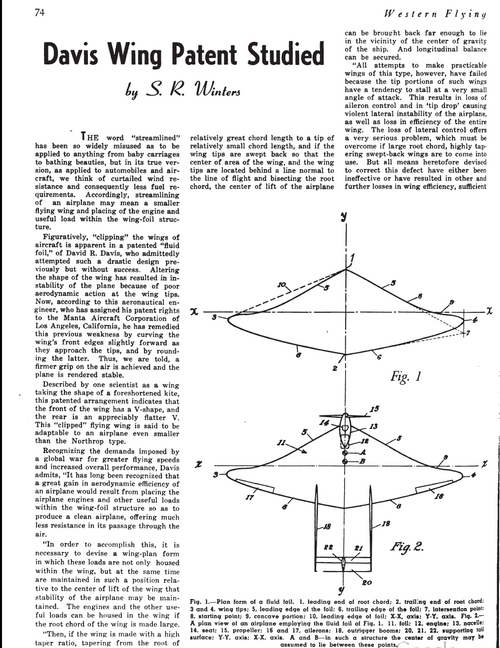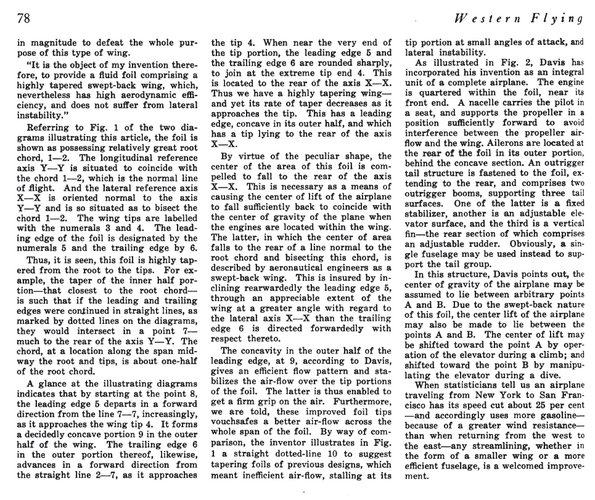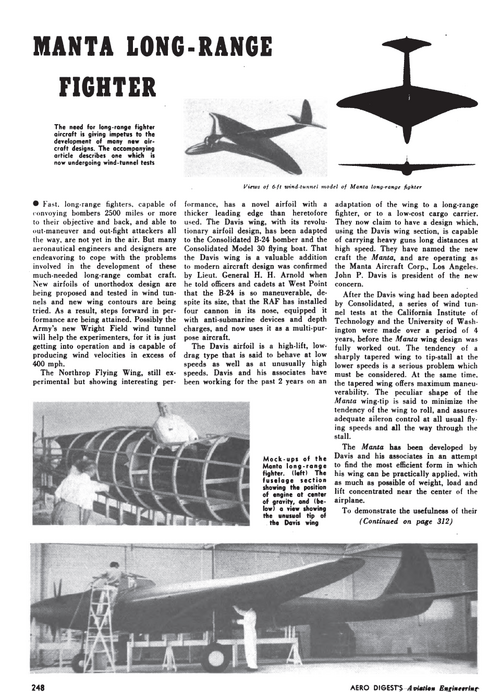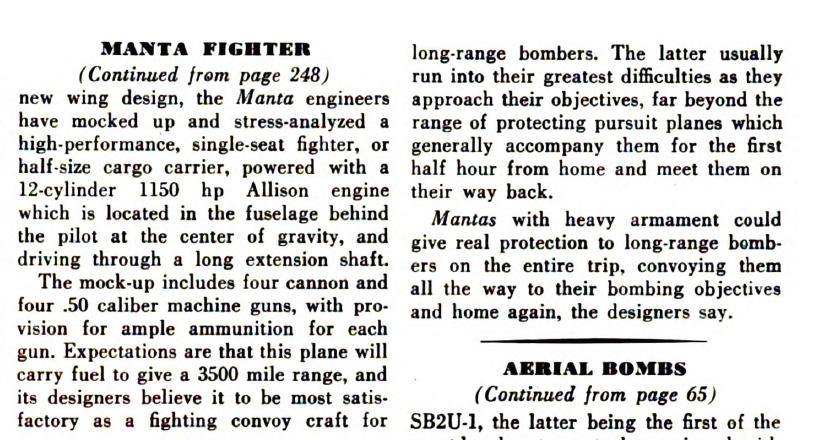You are using an out of date browser. It may not display this or other websites correctly.
You should upgrade or use an alternative browser.
You should upgrade or use an alternative browser.
Davis "Manta"
- Thread starter hesham
- Start date
- Joined
- 26 May 2006
- Messages
- 34,841
- Reaction score
- 15,718
Justo Miranda said:Here some pics of the twin booms version from
-"Die Deutsche Sportflieger" sept 1942
-"Aeronautical Engineering Review" june 1942
-"Luftahrt International" No 25
-"Le Fanatique de l´Aviation" 216-217
My dear Lark,
in first page of topic,my dear Justo mentioned that,there was a twin boom version.
I know Justo's work very well Hesham.
Please, read the tekst with the illustration you posted.
Blended wing/fuselages and pusher prop's were the fashion of the day then
for striking publicity adverts..
Please, read the tekst with the illustration you posted.
Blended wing/fuselages and pusher prop's were the fashion of the day then
for striking publicity adverts..
- Joined
- 11 March 2006
- Messages
- 8,622
- Reaction score
- 3,780
Translation:
"Picture 6: In an advert about the theme "Planes of the Future", the General Tire & Rubber Co. Akron, Ohio
showed in June 1942 this design of a MANTA-like (!) aircraft with twin fins and pusher prop"
"Picture 6: In an advert about the theme "Planes of the Future", the General Tire & Rubber Co. Akron, Ohio
showed in June 1942 this design of a MANTA-like (!) aircraft with twin fins and pusher prop"
- Joined
- 25 June 2009
- Messages
- 14,740
- Reaction score
- 6,092
hesham said:and I thought it was anther variant of it at first,but obviously I was wrong.
... which is why I have told you several times, hesham, not to jump to conclusions if you do not speak the language!!
blackkite said:There was a Manta description in Japanese enemy aircrafts list in 1944.
http://www.tante2.com/tekki-ichiran.html
Cool period ID book, Blackkite, do you know if the intel was shared with Germany?
Or if there was discussion about Allied aircraft performance that included types used only in PTO, or ETO?
Like, did the Luftwaffe want to know about the B-29, & Nippon air forces about the Typhoon/Tempest etc?
blackkite
Don't laugh, don't cry, don't even curse, but.....
- Joined
- 31 May 2007
- Messages
- 8,810
- Reaction score
- 7,684
Hmmm...Your questions are little hard for me.J.A.W. said:blackkite said:There was a Manta description in Japanese enemy aircrafts list in 1944.
http://www.tante2.com/tekki-ichiran.html
Cool period ID book, Blackkite, do you know if the intel was shared with Germany?
Or if there was discussion about Allied aircraft performance that included types used only in PTO, or ETO?
Like, did the Luftwaffe want to know about the B-29, & Nippon air forces about the Typhoon/Tempest etc?
J
joncarrfarrelly
Guest
The top and front view photos of the Manta model used in the Japanese ID book appeared in several commercial publications,
the earliest in my possession is the September 1941 Air Trails. So if the Jpanese had the images, I'm sure the Germans did
as well.
the earliest in my possession is the September 1941 Air Trails. So if the Jpanese had the images, I'm sure the Germans did
as well.
KJ_Lesnick
ACCESS: Top Secret
- Joined
- 13 February 2008
- Messages
- 1,042
- Reaction score
- 112
I did some research on this and I've found some interesting details
- Justo Miranda's drawings while beautiful and details were based upon the premise of the aircraft having a V-3420: It didn't, it in fact was based around the V-1710
- In an effort to obtain money to develop his ideas, David R. Davis exaggerated the capabilities of the airplane quite a bit: It's improbable (except perhaps in a dive) that the aircraft would have been capable of exceeding 400 mph with a V-1710
- From what it would appear, the design might have started baseline development as early as 1935 though I have no idea how much different the concept at that time was in terms of size, weight, and armament.
- Far as I know, it was pitched as a long-range fighter: This might have been the biggest thing against it as the USAAC didn't really wish to develop long-ranged escort fighters
[list type=decimal] - While there were some who felt long-ranged fighters were inherently useful, it would appear they did not believe they were absolutely needed
- They also had self-imposed certain restrictions on such fighter designs: No drop-tanks, the plane had to fly the whole way on internal fuel alone; speed had to be equivalent to enemy interceptors; early proposals even included a rear-gunner (while many would be lead to believe after the Consolidated P-30/PB-2 that they gave up on it, the YFM-1 Airacuda had a waist gunner)
- They also felt they would be greatly more expensive compared to regular fighters and wanted to build up a massive bomber force, as a result they didn't fund them as a rule: The only "exception" was the YFM-1 Airacuda because it was predominantly a long-ranged bomber-destroyer that was also be an escort fighter
KJ_Lesnick
ACCESS: Top Secret
- Joined
- 13 February 2008
- Messages
- 1,042
- Reaction score
- 112
Does anybody have the dimensions of the twin-boomer?
- Joined
- 25 June 2009
- Messages
- 14,740
- Reaction score
- 6,092
KJ_Lesnick said:I did some research on this and I've found some interesting details
Thanks for the new input, KJ.
KJ_Lesnick
ACCESS: Top Secret
- Joined
- 13 February 2008
- Messages
- 1,042
- Reaction score
- 112
Though this is an old thread, I'm curious about something stated in the June 1942 Popular Science article that was posted by Skyblazer in reply #21 (I attached the same file for convenience).
That's a pretty advanced feature, I'm curious if anybody has any idea what kind of plastic could have been used in those days -- the only thing I can think of is PVC (the Vickers Windsor used it) and bakelite (The Yak-9 used it)Welded steel tubing the framework of the craft will be covered with a smoothly molded plastic skin.
Attachments
- Joined
- 8 March 2009
- Messages
- 1,055
- Reaction score
- 1,289
KJ_Lesnick said:Though this is an old thread, I'm curious about something stated in the June 1942 Popular Science article that was posted by Skyblazer in reply #21 (I attached the same file for convenience).
That's a pretty advanced feature, I'm curious if anybody has any idea what kind of plastic could have been used in those days -- the only thing I can think of is PVC (the Vickers Windsor used it) and bakelite (The Yak-9 used it)Welded steel tubing the framework of the craft will be covered with a smoothly molded plastic skin.
Maybe related to "chemurgy" and the soybean and hemp plastics that ford and others were promoting during that time.
- Joined
- 6 November 2010
- Messages
- 5,255
- Reaction score
- 5,488
Polikarpov I-16 and Lavochkin LaGG-1/3 used shpon - a birchwood-bakelite compound - for skin panels.KJ_Lesnick said:That's a pretty advanced feature, I'm curious if anybody has any idea what kind of plastic could have been used in those days -- the only thing I can think of is PVC (the Vickers Windsor used it) and bakelite (The Yak-9 used it)Welded steel tubing the framework of the craft will be covered with a smoothly molded plastic skin.
- Joined
- 25 July 2007
- Messages
- 4,299
- Reaction score
- 4,192
From, Western_Aviation_Missiles_and_Space 1943
Source: Western Flying, Vol XXIII, No. 1, January 1943, Davis Wing Patent Studied by S.R. Winters, pages 74 and 78
hesham: As noted elsewhere, Western Aviation, Missiles, and Space did not exist in the 1940s. Please don't repeat Google Books' unhelpful 'Western_Aviation_Missiles_and_Space' name clumpings!
Between 1926 and 1951, the name of this magazine was Western Flying. After that, LA-based Western Aviation Magazine, Inc. rebranded their publication as the trade magazine: Western Flying before tagging on "including Missile and Space Industries" in 1959. By 1961, it was Western Aviation Missile and Space then, in 1963, it became Western Aerospace.
If you are referencing Google Books for Western Flying, et al, select Section 1 and you will be able to find the actual magazine name, date, volume, number, etc.
Similar threads
-
-
Teledyne Ryan Model 262 'Manta Ray' (STAR)
- Started by Boxman
- Replies: 47
-
Fantômes fourchus (dedicated to Tophe)
- Started by Antonio
- Replies: 12
-
“The Ultimate Allied Fighters of the Second World War” by Justo Miranda
- Started by Justo Miranda
- Replies: 40
-
Who is Marion Davis ? US Test pilot on Dassault Mystère in 1952
- Started by MIRAGE 4000
- Replies: 23

